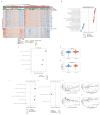This is a preprint.
A distinctive evolution of alveolar T cell responses is associated with clinical outcomes in unvaccinated patients with SARS-CoV-2 pneumonia
- PMID: 38168346
- PMCID: PMC10760069
- DOI: 10.1101/2023.12.13.571479
A distinctive evolution of alveolar T cell responses is associated with clinical outcomes in unvaccinated patients with SARS-CoV-2 pneumonia
Update in
-
Distinctive evolution of alveolar T cell responses is associated with clinical outcomes in unvaccinated patients with SARS-CoV-2 pneumonia.Nat Immunol. 2024 Sep;25(9):1607-1622. doi: 10.1038/s41590-024-01914-w. Epub 2024 Aug 13. Nat Immunol. 2024. PMID: 39138384 Free PMC article.
Abstract
Pathogen clearance and resolution of inflammation in patients with pneumonia require an effective local T cell response. Nevertheless, local T cell activation may drive lung injury, particularly during prolonged episodes of respiratory failure characteristic of severe SARS-CoV-2 pneumonia. While T cell responses in the peripheral blood are well described, the evolution of T cell phenotypes and molecular signatures in the distal lung of patients with severe pneumonia caused by SARS-CoV-2 or other pathogens is understudied. Accordingly, we serially obtained 432 bronchoalveolar lavage fluid samples from 273 patients with severe pneumonia and respiratory failure, including 74 unvaccinated patients with COVID-19, and performed flow cytometry, transcriptional, and T cell receptor profiling on sorted CD8+ and CD4+ T cell subsets. In patients with COVID-19 but not pneumonia secondary to other pathogens, we found that early and persistent enrichment in CD8+ and CD4+ T cell subsets correlated with survival to hospital discharge. Activation of interferon signaling pathways early after intubation for COVID-19 was associated with favorable outcomes, while activation of NF-κB-driven programs late in disease was associated with poor outcomes. Patients with SARS-CoV-2 pneumonia whose alveolar T cells preferentially targeted the Spike and Nucleocapsid proteins tended to experience more favorable outcomes than patients whose T cells predominantly targeted the ORF1ab polyprotein complex. These results suggest that in patients with severe SARS-CoV-2 pneumonia, alveolar T cell interferon responses targeting structural SARS-CoV-2 proteins characterize patients who recover, yet these responses progress to NF-κB activation against non-structural proteins in patients who go on to experience poor clinical outcomes.
Conflict of interest statement
Competing Interest Statement: BDS holds United States Patent No. US 10,905,706 B2, “Compositions and Methods to Accelerate Resolution of Acute Lung Inflammation”, and serves on the Scientific Advisory Board of Zoe Biosciences, outside of the submitted work. The other authors have no competing interests to declare.
Figures






Similar articles
-
Distinctive evolution of alveolar T cell responses is associated with clinical outcomes in unvaccinated patients with SARS-CoV-2 pneumonia.Nat Immunol. 2024 Sep;25(9):1607-1622. doi: 10.1038/s41590-024-01914-w. Epub 2024 Aug 13. Nat Immunol. 2024. PMID: 39138384 Free PMC article.
-
Circuits between infected macrophages and T cells in SARS-CoV-2 pneumonia.Nature. 2021 Feb;590(7847):635-641. doi: 10.1038/s41586-020-03148-w. Epub 2021 Jan 11. Nature. 2021. PMID: 33429418 Free PMC article.
-
Alveolitis in severe SARS-CoV-2 pneumonia is driven by self-sustaining circuits between infected alveolar macrophages and T cells.bioRxiv [Preprint]. 2020 Aug 7:2020.08.05.238188. doi: 10.1101/2020.08.05.238188. bioRxiv. 2020. Update in: Nature. 2021 Feb;590(7847):635-641. doi: 10.1038/s41586-020-03148-w. PMID: 34013276 Free PMC article. Updated. Preprint.
-
SARS-CoV-2-reactive IFN-γ-producing CD4+ and CD8+ T cells in blood do not correlate with clinical severity in unvaccinated critically ill COVID-19 patients.Sci Rep. 2022 Aug 22;12(1):14271. doi: 10.1038/s41598-022-18659-x. Sci Rep. 2022. PMID: 35995830 Free PMC article.
-
Immunopathogenesis of SARS-CoV-2-induced pneumonia: lessons from influenza virus infection.Inflamm Regen. 2020 Oct 12;40:39. doi: 10.1186/s41232-020-00148-1. eCollection 2020. Inflamm Regen. 2020. PMID: 33062077 Free PMC article. Review.
References
Publication types
Grants and funding
- R01 HL153122/HL/NHLBI NIH HHS/United States
- F32 HL162377/HL/NHLBI NIH HHS/United States
- R21 AG075423/AG/NIA NIH HHS/United States
- K08 HL159356/HL/NHLBI NIH HHS/United States
- P01 AG049665/AG/NIA NIH HHS/United States
- U19 AI135964/AI/NIAID NIH HHS/United States
- P01 HL154998/HL/NHLBI NIH HHS/United States
- U01 TR003528/TR/NCATS NIH HHS/United States
- R01 LM013337/LM/NLM NIH HHS/United States
- R01 HL147290/HL/NHLBI NIH HHS/United States
- T32 HL076139/HL/NHLBI NIH HHS/United States
- I01 CX001777/CX/CSRD VA/United States
- R01 ES034350/ES/NIEHS NIH HHS/United States
- R01 HL153312/HL/NHLBI NIH HHS/United States
- UL1 TR001422/TR/NCATS NIH HHS/United States
- T32 AG020506/AG/NIA NIH HHS/United States
- R01 HL158139/HL/NHLBI NIH HHS/United States
- P30 CA060553/CA/NCI NIH HHS/United States
- F31 AG071225/AG/NIA NIH HHS/United States
- R01 HL149883/HL/NHLBI NIH HHS/United States
LinkOut - more resources
Full Text Sources
Research Materials
Miscellaneous
